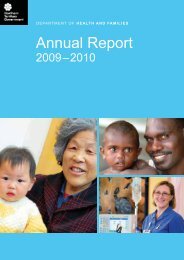PCD Strategy Evaluation 2007.pdf - NT Health Digital Library ...
PCD Strategy Evaluation 2007.pdf - NT Health Digital Library ...
PCD Strategy Evaluation 2007.pdf - NT Health Digital Library ...
You also want an ePaper? Increase the reach of your titles
YUMPU automatically turns print PDFs into web optimized ePapers that Google loves.
was in place in Central Australia in the late 1990‟s). It was expected that all the chronic diseasepublic health nurses would take on a similar role regardless of whether a regional boardemployed them under PHCAP arrangements, or they were employed by <strong>NT</strong>DH&CS. Due to theacute care demands in the <strong>NT</strong>DH&CS clinics, the <strong>NT</strong> Public <strong>Health</strong> nurses take on an operationalrole in service delivery rather than focusing on systems support roles as proposed in 2001.Aboriginal Community Controlled <strong>Health</strong> Services with computerised patient information systemswill have the capacity to report against most of the <strong>NT</strong> AHKPIs, but manual systems will need tobe established in the <strong>NT</strong>DH&CS clinics and non government services that do not have acomputerised patient information system. Many of these indicators are good outcomes measuresfor the key result areas of the <strong>NT</strong><strong>PCD</strong>S and they should be linked as the outcomes indicators forthe strategy.Assessment against objectivePopulation lists are reported to be in place in all health service locations across the NorthernTerritory with the majority of ACCHOs using computerised patient information systems thatsupport a population health approach including the production of population lists, chronic diseaseregisters and recall systems. The <strong>NT</strong>DH&CS have chronic disease registers for communitiesserviced by DMOs and reported having predominantly paper based recall systems. The recallsystems are largely paper based in <strong>NT</strong>DH&CS remote clinics that are cumbersome and thereforenot used consistently by all staff. As at June 30, 2007 there was no regular reporting of chronicdisease activities and outcomes, but that will change as the Aboriginal <strong>Health</strong> Key PerformanceIndicator reporting commences.3.2 WORKFORCEDefinition: The workforce is defined as all health disciplines that provide clinical andeducational services to the <strong>NT</strong> population – physicians, general practitioners, nurses in alllocations, Aboriginal <strong>Health</strong> Workers, allied health professionals and other allied workerssuch as nutritionists, podiatrists etc. Ninety-five percent of the remote workforce is madeup of remote area nurses and Aboriginal health workers, supported by visiting specialists,medical and allied health services (41, 42) .There are two <strong>NT</strong><strong>PCD</strong>S objectives that have been allocated to this workforce section. They relateto staff orientation and a whole of government approach to workforce development.Chapter 3: Progress Against <strong>PCD</strong>S Objectives – <strong>Evaluation</strong> of the <strong>NT</strong> Preventable Chronic Disease <strong>Strategy</strong> 2007 29
















